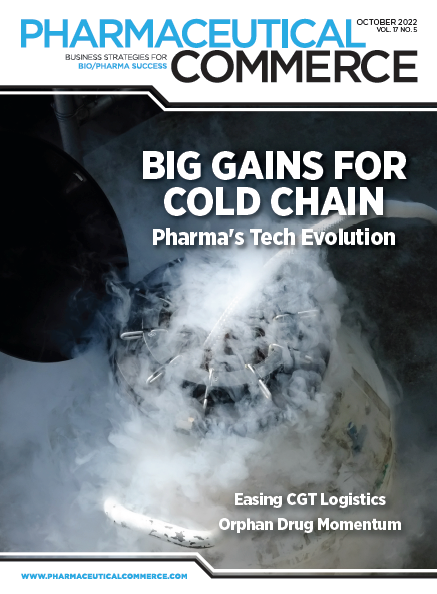Global Logistics: A Cold Chain Blueprint
The growing pipeline of cold chain products holds tremendous promise for patients, but can result in failed shipments if not properly planned for
Pharmaceutical companies today are developing and bringing to market more innovative healthcare products than ever before, ushering in new treatments and vaccines that hold the potential to benefit patients around the world and—in some cases—transform how certain diseases are treated.
The rapid growth of biopharmaceuticals entering the pipeline has been mirrored by a steady increase in products that require cold chain handling (e.g., at temperatures ranging from 2 to 8 °C). And that won’t slow anytime soon. The global market for cold chain products is expected to balloon from $366 billion in 2021 to $480 billion in 2027.1
The growing pipeline of cold chain products, such as biologics, holds tremendous promise for patients worldwide. However, these products also introduce unique logistics challenges and considerations, which—if not properly planned for—can result in failed shipments. Products need to remain in the appropriate condition, including the specified temperature range, from the moment a shipment leaves the manufacturer’s facility through to the point of administration—no matter the external factors. A single temperature excursion can threaten a product’s integrity and efficacy, rendering it useless and resulting in significant financial losses and, more importantly, delayed patient access.
As significant R&D investments and scientific advances power breakthroughs in medicine, it’s increasingly important that biopharma companies and their logistics partners design and execute end-to-end strategies that incorporate temperature-controlled solutions, validated storage, and advanced tracking capabilities to maintain product quality throughout transport and ensure the products can reach the patients who need them—no matter where they live.
Advances in temperature-controlled packaging
Driven by the increased supply of cold chain products, the demand for cold chain packaging and storage solutions continues to surge. In North America and Europe, the healthcare cold chain logistics services market is projected to increase over the next five years, with sales reaching $5 billion and $4.7 billion, respectively, in 2027.1 As the demand increases, logistics partners continue to prioritize investments to expand storage capacity in key markets and develop innovative solutions to enable long-distance deliveries. Alloga, for example, continues to expand its cold chain storage capacity across its network of facilities throughout Europe. With the addition of a new unit in early 2023, Alloga UK will have doubled its chilled storage capacity since 2017.

Packaging solutions and monitoring capabilities, in particular, represent a growing portion of global biopharma logistics spending. In 2020, nearly 30% of the $17.5 billion spent on pharmaceutical cold chain logistics went toward packaging costs, as well as tracking technology and monitoring solutions, like data loggers. That figure reflects the heightened demand for end-to-end visibility, as well as the essential role cold chain packaging plays in protecting product integrity and quality throughout deliveries.
Technological advances and innovation in design has led to the emergence of packaging solutions that offer extended temperature stability, enabling reliable deliveries over longer distances and protection against potential challenges, such as airport custom delays or shipments through extreme climates. As such, biopharma companies are engaging their logistics partners earlier in the clinical or commercialization process to identify a solution that supports their needs and the specific product requirements. For example, the temperature-controlled experts at World Courier’s Climate Optimization Research and Engineering (CORE) Labs use a climate chamber to test and validate all types of packaging against a variety of conditions, including a full range of temperatures. After examining the testing results, the team can select—or develop—a solution the supports the manufacturer’s needs and recommend the most efficient transport route.
Visibility throughout the supply chain
Given the highly sensitive nature and value of these products, biopharma companies seek partners that can deploy tracking technology and monitoring tools to deliver end-to-end visibility, including real-time updates on precise location and internal temperature. The enhanced visibility is increasingly important in today’s healthcare environment, in which products are being shipped over longer distances and across multiple countries.
Global regulatory agencies, including FDA and the European Commission, have established guidelines related to the transport of temperature-sensitive drugs to ensure the integrity of pharmaceutical products. The increased oversight underscores the need for more robust data collection and documentation across the supply chain. Logistics providers should leverage technologies and systems that deliver metrics to a secure, cloud-based platform that can be accessed by their biopharma clients and their internal teams. The real-time data not only provides proof of shipment stability, but also enables teams to anticipate or identify potential risks and take corrective measures to prevent any impact to the product.
Global cryogenic transportation and storage
One factor driving the growth of cold chain logistics, and cryogenic storage in particular, is the influx of cell and gene therapies (CGTs) entering the pipeline. The need for cryogenic storage and transportation is expected to increase significantly in the next few years, with considerable growth needed to support clinical trials. The CGT market in Europe is projected to spike by 23% by 2026.2 During that same timeframe, the UK, Switzerland, and Germany will experience a more than 20% growth in cryogenic transportation and storage needs related to in-country clinical trials. That percentage balloons to 38% in the US.
The ultra-frozen (as low as 80°C) or cryogenic (as low as -196°C) requirements, coupled with the extremely short self-life of many of these products, add another layer of complexity to the supply chain, demanding near flawless execution throughout the distribution process. Now more than ever before, biopharma companies seek partners that can deliver services—such as global cryogenic capabilities or combined transportation and warehousing—to simplify challenges across distribution and ensure products reach the patients who need them. To anticipate and meet these evolving needs, logistics providers need to continue to prioritize investments in their storage network, shipping capabilities, and technology platforms. For example, World Courier has doubled its cryogenic storage capacity across its 18 global clinical and commercial depots since 2021.
Unlocking access to the next wave of products
As the pace of innovation across healthcare continues to accelerate and the pharmaceutical market becomes increasingly globalized, biopharma companies should engage their logistics partners early in the planning process to build a strategy that meets their needs—whether they are looking for a complete cold or cryogenic supply chain via a single source, or a partner with vast storage and transportation capabilities to support a clinical trial throughout Europe.
References
1. Research and Markets. Global Healthcare Cold Chain Logistics Market Report & Forecast (2022-2027). April 2022.
2. Research and Markets. Cell and Gene Therapy Market — Global Market Opportunities and Strategies to 2030: COVID-19 Growth and Change. June 2021.
About the Authors
Nick Porter is President of World Courier (part of AmerisourceBergen). Chris Williams is SVP and International Managing Director of Alloga Europe and ICS (part of AmerisourceBergen).

Strategic Trends in Pharmaceutical Manufacturing for Industry Leaders
March 10th 2025This link in the pharma supply chain is undergoing a major transformation propelled by technological advancements, regulatory changes, and evolving market dynamics, requiring industry leaders to adopt innovative strategies in order to remain competitive.